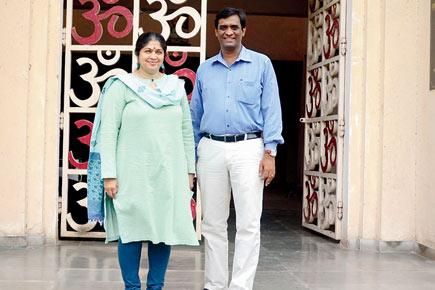Pegged at Rs 4 lakh, Mumbai University’s most expensive master’s course yet, a leadership programme meant for CEOs, is the effort of a group of ambitious professors, who dug deep into India’s ancient past to find out what it takes to be a good leader

The third century BC saw the Maurya Dynasty thrive and rule almost all of ancient India. And, they managed to do so with great flourish for nearly 150 years. Historians would credit the able leadership of rulers like Chandragupta Maurya and Ashoka for this success story. But, not acknowledging the role of the Arthashastra, authored by Chanakya, also known as Kautilya — chief advisor to Chandragupta — would mean a clear disregard for the rich political literature of our past, claim professors at the University of Mumbai.

Professors Dr Radhakrishnan Pillai and Dr Madhavi Narsalay outside the Sanskrit department at the University of Mumbai’s Kalina campus. Dr Pillai, who has been engaging in Chanakya’s literature for the last 15 years, will be coordinating the leadership science degree course at the University. Pic/Sneha Kharabe
ADVERTISEMENT
It was the curiosity for this 2,300-year-old ancient treatise on statecraft, law and order, and economic policy that first got these academicians to work on an experimental project in 2010. Helmed by Prof Dr Shubhada Joshi, the then HOD of philosophy at the MU, the professors selected a group of research students from across India that was put through a rigorous six-month grind of studying Chanakya’s Arthashastra. “Every six months, a new batch of 15 students would work on this paper,” says Prof Dr Radhakrishnan Pillai from the department of philosophy.
The setting was like that of a gurukul, where the students were hosted at the University for free. “After they completed their research, they were asked to enrol in various kinds of political systems, and apply their learning there,” says Pillai about the corporate-funded project. The idea was to see if the students would be able to incorporate their knowledge of governance acquired from the text, while working alongside present-day establishments. “Today, we have over 20 students working in political parties across the country. One of them has even ended up winning a panchayat election in Arunachal Pradesh, while some are contesting the 2017 elections,” Pillai says proudly.

In 2010, Prof Dr Shubhada Joshi, conducted an experimental research project to study the feasibility of Chanakya’s Arthashastra, in today’s times. MU then decided to create a full-fledged degree course around it. pic/DATTA KUMBHAR
Six years later, Prof Dr Sanjay Deshmukh, vice-chancellor, MU, envisioned creating a new degree course that would take off from Dr Joshi’s experiment. Needless to say, the research project’s success was instrumental in the creation of a first-of-its-kind Masters in Leadership Science degree programme, which will be inaugurated at the MU on August 9. The course harks back to ancient texts like the Arthashastra as well as Indian mythology like the Mahabharata, to teach and hone leadership qualities.

Making it happen
“Our research proved that the model of the Arthashastra was still applicable and relevant to our life and times today,” says Joshi, who has now retired and is part of the board of studies at the MU. But, the project would have been a success only on paper, hadn’t Deshmukh thought of creating a course around it, she adds.
In 2015, the VC approached Pillai and Joshi with the germ of the idea, after which professors from other departments were asked to come on board, to see if such a course was workable. “When the idea was suggested to us, I thought it to be the ideal laboratory for application of ancient texts,” says Prof Dr Madhavi Narsalay, HOD of Sanskrit.
“We decided to make it an inter-disciplinary kind of course, where the philosophy, Sanskrit, law and management departments would come up with something that would be beneficial for the youth and administrators,” adds Narsalay. The departments were, however, working against time, having to create an ‘out-of-the-box’ syllabus so that they could introduce the degree course this year.
“For the first time, students were to be studying leadership as a science. And hence, it required a lot of rigour to get it passed at the academic level,” says Pillai.
Normally, it takes around a year to put together a syllabus. “Even after the syllabus is prepared, it needs the stamp of approval of the board of studies, the academic council, management council, and the governor,” says Narsalay.
Going back to heritage
The question, however, was whether such an antiquated course held any substance? Pillai, who has previously written books like Corporate Chanakya and Chanakya’s Seven Secrets of Leadership, doesn’t see why such a model shouldn’t work.
“We have a lot of rich literature in our country, but nobody studies it academically. The problem is that it is not packaged well,” says Pillai, who is currently coordinating the master’s programme. “Every time, one can’t devise a course that is West-centric,” adds Narsalay.
She explains, “In the Arthashastra, Chanakya has written over 6,000 sutras, or rather formulae, on the qualifications of a good leader. He further discusses aspects of good governance, role of civic society, inter-state relations, infrastructure, etc. It is only a matter of imbibing the ideas into our present-day lives.”
Apart from this, the course will also look at texts like Kamandaka Nitisara, Shukra Niti among others. “We also have portions from the Mahabharata, where Raj Dharma is discussed in detail,” Joshi says. But, that doesn’t mean modern-day concepts of leadership will be ignored,” says Pillai.
A notch above MBA degrees
At present, MU is offering a full-time two-year masters programme in Leadership Science. The self-funded course has been split into four semesters, comprising four papers each, and with the fees being pegged at R4 lakh, it is being touted as MU’s most expensive course yet. According to Pillai, a few corporates have already shown interest in the course and are willing to shell out the entire fee, to train talented staff.
To add to this, a fancy roster of guest speakers makes this course an immediate draw. Pillai says PM Narendra Modi, CMs from across India, IAS and IPS officers, as well as businessmen like Ratan Tata and the Ambanis, would be invited to speak with the students.
“Today, we need good leaders. Nobody teaches you leadership in the academic world. This is why I consider the course a cut above the existing management courses being offered in the country,” he says, adding, “I see potential leaders emerging from here.”
 Subscribe today by clicking the link and stay updated with the latest news!" Click here!
Subscribe today by clicking the link and stay updated with the latest news!" Click here!







